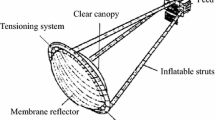Abstract
The membrane reflector antenna (MRA) possesses significant advantages, such as being light in weight and having a large storage ratio. As a result, it is considered one of the critical forms of space-borne antennas. However, the MRA faces a challenge in that it is easily impacted by thermal loads in space, and there is a lack of effective shape adjustment means. To address this issue, a bidirectional adjustment method has been proposed utilizing electrostatic forces and boundary cable forces. Firstly, the mechanical analysis model of the MRA, including the cable-membrane-truss structure, is constructed based on the energy variation principle. Then the calculation formula of electrostatic forces has been deduced considering the change in the distance between the membrane reflector surface and the membrane control surface. The update process of electrostatic forces has also been presented. Finally, an optimization model of the shape adjustment of the MRA has been established, with electrode voltages and boundary cable forces as design variables and the surface accuracy of the membrane reflector as the optimization goal. Simulation examples have been conducted under three types of temperature loads, and a 10:1 scaled experimental prototype has been used to verify the effectiveness of the shape adjustment method.














Similar content being viewed by others
Data availability
The data underlying this paper will be shared to the readers on reasonable request.
References
Duan B (2020) Large space-borne deployable antennas (LSDAs)—a comprehensive summary. Chin J Electron 29(1):1–15
Im E, Thomson M, Fang H et al. (2007) Prospects of large deployable reflector antennas for a new generation of geostationary Doppler weather radar satellites. In: AIAA SPACE 2007 conference & exposition, Long Beach, California, 18–20 September 2007, AIAA 2007-9917
Zhang S, Song J (2021) Surface segmentation design using a weighting level set topology optimization method for large radio telescope antennas. Struct Multidiscip Optim 64(2):905–918
Zhang S, Duan B (2020) Topology optimization of continuum supporting structures for microwave antenna applications. Struct Multidiscip Optim 62(5):2409–2422
Liu T, Wang X, Qiu X et al (2020) Theoretical study on the parameter sensitivity over the mechanical states of inflatable membrane antenna. Aerosp Sci Technol 102:105843
Sun Z, Duan B, Zhang Y et al (2022) Multi-material optimization design for mesh reflector antennas considering space thermal effects. Struct Multidiscip Optim 65(6):1–11
Zhang S, Duan B (2020) Integrated structural-electromagnetic optimization of cable mesh reflectors considering pattern degradation for random structural errors. Struct Multidiscip Optim 61(4):1621–1635
Chandra M, Kumar S, Chattopadhyaya S, Chatterjee S, Kumar P (2021) A review on developments of deployable membrane-based reflector antennas. Adv Space Res 68(9):3749–3764
Hill J, Wang KW, Fang H (2013) Advances of surface control methodologies for flexible space reflectors. J Spacecr Rocket 50(4):816–828
Yoon H (2013) Optimal shape control of adaptive structures for performance maximization. Struct Multidiscip Optim 48(3):571–580
Fang H, Pattom M, Wang K et al. (2007) Shape control of large membrane reflector with PVDF actuation. In: 48th AIAA/ASME/ASCE/AHS/ASC structures, structural dynamics, and materials conference, Honolulu, Hawaii, 23–27 April 2007, AIAA 2007-1842
Chodimella S, Moore J, Otto J, Fang H (2006) Design evaluation of a large aperture deployable antenna. In: 47th AIAA/ASME/ASCE/AHS/ASC structures, structural dynamics, and materials conference, Newport, Rhode Island, May 1–4, 2006, AIAA 2006-1603
Duan B, Gao F, Du J et al (2015) Optimization and experiment of an electrostatic forming membrane reflector in space. J Mech Sci Technol 29(4):1355–1360
Gu Y, Duan B, Du J (2018) The establishment and application of direct coupled electrostatic-structural field model in electrostatically controlled deployable membrane antenna. Acta Astronaut 146:185–191
Zhang Y, Gao F, Zhang S et al (2015) Electrode grou** optimization of electrostatic forming membrane reflector antennas. Aerosp Sci Technol 41:158–166
Liu C, Yang G, Zhang Y (2015) Optimization design combined with coupled structural–electrostatic analysis for the electrostatically controlled deployable membrane reflector. Acta Astronaut 106:90–100
Jenkins CH, Schur WW (2001) Gore/seam architectures for Gossamer structures. J Spacecr Rocket 39(5):669–673
Desmidt HA, Wang KW, Fang H (2015) Optimized gore/seam cable-actuated shape control of Gossamer membrane reflectors. J Spacecr Rocket 44(5):1122–1130
Lindler J, Flint E (2004) Boundary actuation shape control strategies for thin film single surface shells. In: 45th AIAA/ASME/ASCE/AHS/ASC structures, structural dynamics & materials conference, Palm Springs, California, 19–22 April 2004, AIAA 2004-1825
Gu Y, Du J, Yang D et al (2018) Form-finding design of electrostatically controlled deployable membrane antenna based on an extended force density method. Acta Astronaut 152(11):757–767
Cao S, Zhou H, Feng Y et al (2021) Thermal design and simulation of space-borne membrane antenna. J Therm Anal Calorim 146:2317–2321
Acknowledgements
The authors would like to express gratitude to the staff of the Research Institute on Mechatronics, **dian University, China, for their assistance in the experiments in this paper.
Funding
This work was supported by the National Natural Science Foundation of China (No: 52005277).
Author information
Authors and Affiliations
Corresponding author
Ethics declarations
Conflict of interest
The authors declare that they have no conflict of interest.
Ethical approval
This article does not contain any studies with human participants or animals performed by any of the authors.
Replication of results
The results presented in this study can be replicated by implementing the formulas and data structures presented in this study. The code and data for producing the presented results will be made available by request.
Additional information
Publisher's Note
Springer Nature remains neutral with regard to jurisdictional claims in published maps and institutional affiliations.
Rights and permissions
Springer Nature or its licensor (e.g. a society or other partner) holds exclusive rights to this article under a publishing agreement with the author(s) or other rightsholder(s); author self-archiving of the accepted manuscript version of this article is solely governed by the terms of such publishing agreement and applicable law.
About this article
Cite this article
Zhong, W., Gu, Y., Zhang, S. et al. Simulation and Experimental Research on Shape Adjustment of Membrane Reflector Antenna (MRA) Combined with Electrostatic Forces and Boundary Cable Forces. Int. J. Aeronaut. Space Sci. 25, 435–448 (2024). https://doi.org/10.1007/s42405-023-00659-4
Received:
Revised:
Accepted:
Published:
Issue Date:
DOI: https://doi.org/10.1007/s42405-023-00659-4




